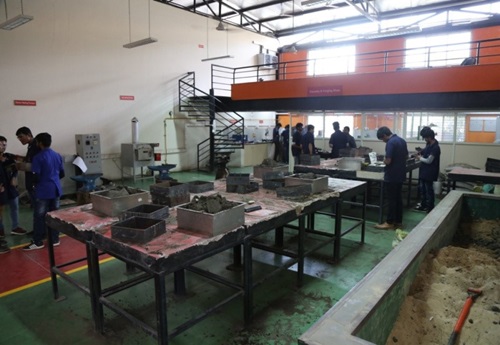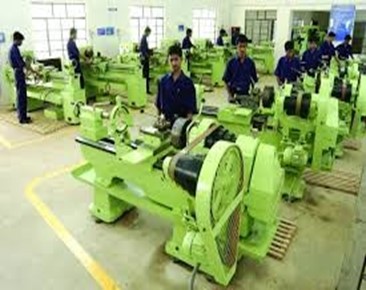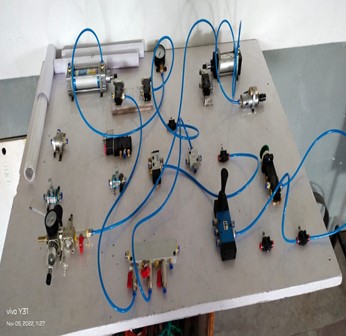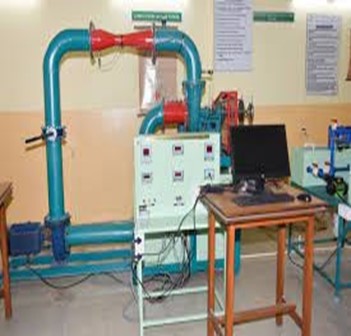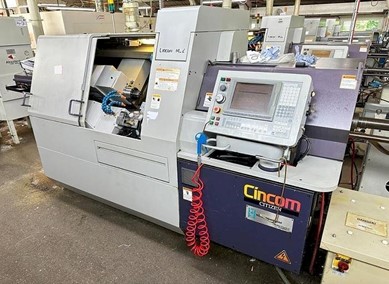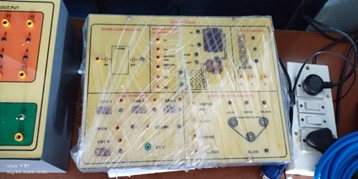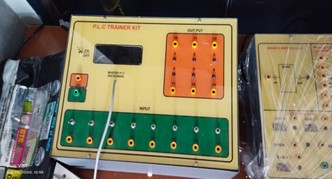1. MECHANICAL WORK SHOP PRACTICE LAB
Beginning with the Industrial Revolution era, a workshop may be a room, rooms or building which provides both the area and tools (or machinery) that may be required for the manufacture or repair of manufactured goods. Workshops were the only places of production until the advent of industrialization and the development of larger factories. In the 20th and 21st century, many Western homes contained a workshop in the garage, basement, or an external shed. Home workshops typically contain a workbench, hand tools, power tools, and other hardware. Along with the practical application of repairing goods, workshops are often used to tinker and make prototypes.
Some workshops focus exclusively on automotive repair or restoration although there are a variety of workshops in existence today. Woodworking, metalworking, electronics, and other types of electronic prototyping workshops are among the most common.
2. MANUFACTURING PROCESSES LAB
A foundry is a factory that produces metal castings. Metals are cast into shapes by melting them into a liquid, pouring the metal into a mold, and removing the mold material after the metal has solidified as it cools. The most common metals processed are aluminum and cast iron. However, other metals, such as bronze, brass, steel, magnesium, and zinc, are also used to produce castings.
Forging is a manufacturing process involving the shaping of metal using localized compressive forces. The blows are delivered with a hammer (often a power hammer) or a die. Forging is often classified according to the temperature at which it is performed: cold forging (a type of cold working), warm forging, or hot forging (a type of hot working). For the latter two, the metal is heated, usually in a forge. Forged parts can range in weight from less than a kilogram to hundreds of metric tons. Forging has been done by smiths for millennia; the traditional products were kitchenware, hardware, hand tools, edged weapons, cymbals, and jewellery.
3. MACHINE TOOL TECHNOLOGY LAB
A machine shop or engineering workshop is a room, building, or company where machining, a form of subtractive manufacturing, is done. In a machine shop, machinists use machine tools and cutting tools to make parts, usually of metal or plastic (but sometimes of other materials such as glass or wood). A machine shop can be a small business (such as a job shop) or a portion of a factory, whether a tool room or a production area for manufacturing. The building construction and the layout of the place and equipment vary, and are specific to the shop; for instance, the flooring in one shop may be concrete, or even compacted dirt, and another shop may have asphalt floors. A shop may be air-conditioned or not; but in other shops it may be necessary to maintain a controlled climate. Each shop has its own tools and machinery which differ from other shops in quantity, capability and focus of expertise.
4. FLUID POWER ENGINEERING LAB
Fluid power is the use of fluids under pressure to generate, control, and transmit power. Fluid power is conventionally subdivided into hydraulics (using a liquid such as mineral oil or water) and pneumatics (using a gas such as compressed air or other gases). Although steam is also a fluid, steam power is usually classified separately from fluid power (implying hydraulics or pneumatics). Compressed-air and water-pressure systems were once used to transmit power from a central source to industrial users over extended geographic areas; fluid power systems today are usually within a single building or mobile machine.
Fluid power systems perform work by a pressurized fluid bearing directly on a piston in a cylinder or in a fluid motor. A fluid cylinder produces a force resulting in linear motion, whereas a fluid motor produces torque resulting in rotary motion. Within a fluid power system, cylinders and motors (also called actuators) do the desired work. Control components such as valves regulate the system.
5. CNC PROGRAMMING AND MACHINING LAB
In machining, numerical control, also called computer numerical control (CNC),[1] is the automated control of tools by means of a computer. It is used to operate tools such as drills, lathes, mills, grinders, routers and 3D printers. CNC transforms a piece of material (metal, plastic, wood, ceramic, stone, or composite) into a specified shape by following coded programmed instructions and without a manual operator directly controlling the machining operation.
6. ELEMENTS OF INDUSTRIAL AUTOMATION LAB
Laboratory automation is a multi-disciplinary strategy to research, develop, optimize and capitalize on technologies in the laboratory that enable new and improved processes. Laboratory automation professionals are academic, commercial and government researchers, scientists and engineers who conduct research and develop new technologies to increase productivity, elevate experimental data quality, reduce lab process cycle times, or enable experimentation that otherwise would be impossible.
The most widely known application of laboratory automation technology is laboratory robotics. More generally, the field of laboratory automation comprises many different automated laboratory instruments, devices (the most common being autosamplers), software algorithms, and methodologies used to enable, expedite and increase the efficiency and effectiveness of scientific research in laboratories.




